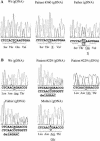Mutations in the sepiapterin reductase gene cause a novel tetrahydrobiopterin-dependent monoamine-neurotransmitter deficiency without hyperphenylalaninemia
- PMID: 11443547
- PMCID: PMC1235302
- DOI: 10.1086/321970
Mutations in the sepiapterin reductase gene cause a novel tetrahydrobiopterin-dependent monoamine-neurotransmitter deficiency without hyperphenylalaninemia
Abstract
Classic tetrahydrobiopterin (BH(4)) deficiencies are characterized by hyperphenylalaninemia and deficiency of monoamine neurotransmitters. In this article, we report two patients with progressive psychomotor retardation, dystonia, severe dopamine and serotonin deficiencies (low levels of 5-hydroxyindoleacetic and homovanillic acids), and abnormal pterin pattern (high levels of biopterin and dihydrobiopterin) in cerebrospinal fluid. Furthermore, they presented with normal urinary pterins and without hyperphenylalaninemia. Investigation of skin fibroblasts revealed inactive sepiapterin reductase (SR), the enzyme catalyzing the final two-step reaction in the biosynthesis of BH(4). Mutations in the SPR gene were detected in both patients and their family members. One patient was homozygous for a TC-->CT dinucleotide exchange, predicting a truncated SR (Q119X). The other patient was a compound heterozygote for a genomic 5-bp deletion (1397-1401delAGAAC) resulting in abolished SPR-gene expression and an A-->G transition leading to an R150G amino acid substitution and to inactive SR as confirmed by recombinant expression. The absence of hyperphenylalaninemia and the presence of normal urinary pterin metabolites and of normal SR-like activity in red blood cells may be explained by alternative pathways for the final two-step reaction of BH(4) biosynthesis in peripheral and neuronal tissues. We propose that, for the biosynthesis of BH(4) in peripheral tissues, SR activity may be substituted by aldose reductase (AR), carbonyl reductase (CR), and dihydrofolate reductase, whereas, in the brain, only AR and CR are fully present. Thus, autosomal recessive SR deficiency leads to BH(4) and to neurotransmitter deficiencies without hyperphenylalaninemia and may not be detected by neonatal screening for phenylketonuria.
Figures



References
Electronic-Database Information
-
- BIODEF: International Database of Tetrahydrobiopterin Deficiencies, http://www.bh4.org/biodef1.html (for patients 229 and 360) - PubMed
-
- GenBank, http://www.ncbi.nlm.nih.gov/Genbank/ (for SR genomic DNA [accession numbers AB017547 and AB017548] and SR cDNA [accession number M76231])
-
- Online Mendelian Inheritance in Man (OMIM), http://www.ncbi.nlm.nih.gov/Omim/ (for DRD [MIM 600225], PKU [MIM 261600], PTPS deficiency [MIM 261640], and DHPR deficiency [MIM 261630])
References
-
- Blau N, Barnes I, Dhondt JL (1996) International database of tetrahydrobiopterin deficiencies. J Inherit Metab Dis 19:8–14 - PubMed
-
- Blau N, Thöny B, Cotton RGH, Hyland K (2001) Disorders of tetrahydrobiopterin and related biogenic amines. In: Scriver CR, Beaudet AL, Sly WS, Valle D, Childs B, Vogelstein B (eds) The metabolic and molecular bases of inherited disease, 8th ed. McGraw-Hill, New York, pp 1725–1776
-
- Blau N, Thöny B, Renneberg A, Arnold LA, Hyland K (1998) Dihydropteridine reductase deficiency localized to the central nervous system. J Inherit Metab Dis 21:433–434 - PubMed
-
- Blau N, Thöny B, Renneberg A, Penzien JM, Hyland K, Hoffmann G (1999) Variant of dihydropteridine reductase deficiency without hyperphenylalaninemia: effect of oral phenylalanine loading. J Inherit Metab Dis 22:216–220 - PubMed
Publication types
MeSH terms
Substances
Associated data
- Actions
- Actions
- Actions
- Actions
- Actions
- Actions
- Actions
LinkOut - more resources
Full Text Sources
Other Literature Sources
Medical
Molecular Biology Databases
Research Materials

